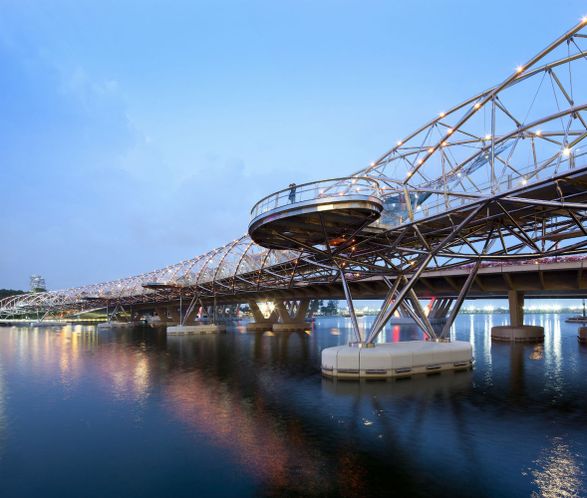ARCHITECTS
Cox Architecture + Architects 61
CATEGORY
Pedestrian Bridge
AREA
1379.08 m²
YEAR
2010
PHOTOGRAPHS
Christopher Frederick Jones, Angus Martin
The Helix Bridge provides a pedestrian connection across the head of the Singapore River between the city’s existing CBD and its new Bayfront district.
Its commission was the result of a selected 36-entry international design competition held in 2006.
The plan concept was to curve the bridge in an arc so that it arrives fluidly into foreshore promenades on each side.
It also enabled the bridge to connect in its centre to an adjacent vehicular bridge’s footpath while shifting away from it beyond this point of junction.
Seeking a delicate, lightweight contrast to the vehicular bridge, the concept evolved of a double helix structure.
This form enabled the canopy, required by the brief, to be integrated as segmented panels of glass and perforated steel, unlike other bridge structures. The structural typology also proved highly effective in working to a curvilinear plan, and in generating an intriguing sense of movement flow along the journey.
The Helix Bridge is illuminated at night by ribbons of LED lighting accentuating the interplay of the two helix tubes and their intervening, connecting ties. Four ovular-shaped ‘pods’ cantilever out from the structure enabling people to gain wider appreciation of the bridge form and providing gathering space for viewing bay events.
Conceptual Framework The design of The Helix Bridge responds to the brief of an international architectural competition calling for a unique structural form that could be symbolic of Singapore’s goal of promoting the identity of Asia’s ‘connected city’.
The plan concept was to curve the bridge away from an adjoining linear vehicular bridge, such that it touched at a point for pedestrian interconnection, yet descended in each direction to fluidly continue along existing promenades at each end.
The double helix structure was conceived as both a highly efficient and exciting form that integrated with the curvilinear plan. It forms a dynamic spatial experience as well as, unlike other bridge structures, enables the canopy to be integrated into the segments between the helix tubes and their interconnecting ties.
Public + Cultural Benefits The Helix Bridge forms an essential public link across the Singapore River mouth between the city’s existing CBD and its newly developing Bayfront District.
Its curved arc in plan enables people to descend continuously into the bayfront promenades on each side, linking these points with existing major cultural facilities such as the Michael Wilford- designed Esplanade National Performing Arts Centre. From a symbolic perspective, Singapore sees the design as emulating DNA and conveying a spirit of revitalisation.
Relationship of Built Form to Context The Helix Bridge runs adjacent to two linear concrete vehicular bridges. It was felt that running a further parallel, linear bridge alongside these would both congest the crossings and leave the pedestrian bridge as a meagre adjunct to the vehicular bridges.
Curving the new bridge away both facilitated its presence and enabled it to meet a point where people can interchange. The curvature also helped to form a sense of containment to the bay and to act as a viewing arena to Marina Bay’s many water events.
Program Resolution The Helix Bridge is the world’s only double helix bridge which delights the client (Singapore Government) as uniqueness was a prerequisite of the brief to distinguish Singapore as a ‘connected city’.
However, the double helix structure proved to be an ideal response to the requirement to fluidly connect the bridge into existing promenades on each side which are perpendicular to each other. It also facilitated integration of canopy and lighting, also brief requirements.
Integration of Allied Disciplines The bridge design is the product of inseparable collaboration between architect (Cox Rayner / Architects 61) and engineer Arup. Its recognition as an art form also stimulated the Government to create an adjoining Art Park comprising school student works which we assisted in selecting siting.
Cost / Value Arup found that for its 280 metre length, the dual helix structure utilises 5 times less steel than a conventional box girder bridge. This finding enabled the client to direct the structure to be constructed entirely of stainless steel for its longevity. Sustainability The bridge’s environmental performance is implicit in the use of minimal steel noted above, this being a key objective of the design.
Additional Benefits Its four cantilevered decks utilising the bridge’s structural natural rigidity to add these expansive external viewing platforms.

















